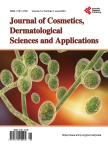Effect of a Thermal Spring Water on Carbohydrate-Protein Interactions in In-Vitro Models Implicating Normal Human Keratinocytes and Recombinant Lectins
Effect of a Thermal Spring Water on Carbohydrate-Protein Interactions in In-Vitro Models Implicating Normal Human Keratinocytes and Recombinant Lectins作者机构:GLYcoDiag 2 rue du cristal Orléans France EPHYSCIENCE 498ter route de Saint Joseph de Porterie Nantes France Laboratoires Dermatologiques d’Uriage Neuilly-sur-Seine France
出 版 物:《Journal of Cosmetics, Dermatological Sciences and Applications》 (化妆品、皮肤病及应用期刊(英文))
年 卷 期:2023年第13卷第4期
页 面:269-276页
学科分类:08[工学] 0812[工学-计算机科学与技术(可授工学、理学学位)]
主 题:Carbohydrate-Protein Interaction Lectin Dectin-1 Langerin Normal Human Keratinocytes Immune System
摘 要:Background: Sugar moiety of macromolecules is today very well known for its implications in many biological recognition mechanisms including cell-cell, extracellular matrix-cell and/or bacteria-cell interactions. In this context lectins, which are carbohydrate-binding proteins displaying a high affinity for sugar groups of other molecules, are of a great importance, notably in immune response involving bacteria, viruses and fungi. As protein-carbohydrate interactions are often mediated by ions such as calcium, zinc or magnesium, we were prompted to study the effect of a thermal spring water (which contains this type of component) on interactions existing between: 1) osidic receptors of human normal keratinocytes and 2) two lectins greatly implicated in the immune response mechanisms (i.e. the dectin-1 and the langerin), and their ligands. Materials and Methods: In a first series of experiments, we studied the effect of increasing concentrations of a thermal spring water on interactions existing between glycosylated molecules and the osidic receptors expressed at the normal human keratinocytes surface. In a second step, and in order to better understand the putative effect of our thermal spring water on the immune response, we analyzed its effect on the interactions existing between the dectin-1 (implicated in the recognition of bacteria, viruses and fungi) and the langerin (expressed by Langerhans cells, the immune cells of the cutaneous tissue), and their ligands in a model using recombinant human lectins and appropriate binding molecules. Results: We showed here that our thermal spring water was able to reinforce interactions between keratinocytes osidic receptors and some of their ligands, in a dose-related manner: From 8% to 55% of increase with 10% to 30% (v/v) of thermal spring water. In the second part of our studies, we also showed that our thermal spring water was able to modulate interactions between dectin-1 and langerin and their ligands through a biphas



